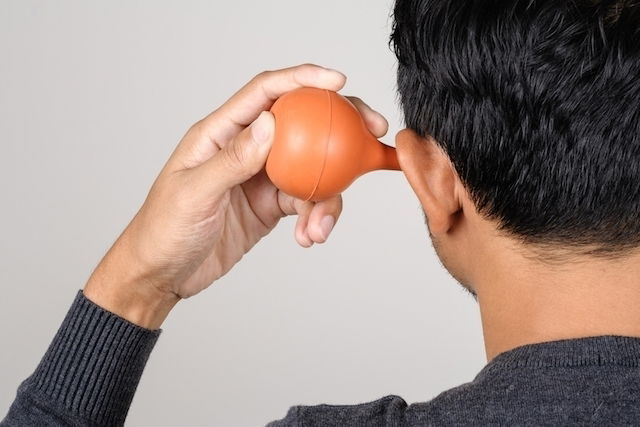Ear wax removal can be done at home with methods like cleaning the inner ear area with a towel or applying a few drops of oil inside the ear to soften wax. You can also purchase pharmacy remedies to help remove wax.
Ear wax is needed to protect the ear from infection and to prevent the entry of bacteria, dust, insects, water and sand into the ear canal. However, excess ear wax can block or plug the ear, leading to discomfort or even mild hearing loss.
Also recommended: Clogged Ear: Main Causes, Symptoms & Treatment tuasaude.com/en/clogged-earsEar wax removal at home can be done, however these methods should not replace a medical assessment and irrigation completed by the doctor. Excessive ear wax should be a assessed by a doctor, especially if it clogs your ears, or causes pain, itching, dizziness or fever.

How to remove ear wax
Some ways to remove ear wax at home include:
1. Cleaning the ear with a towel
Cleaning the inner region of the ear with a towel is an excellent way to remove earwax. Excessive ear wax tends to move outward as a natural elimination mechanism, and this wax can be removed with a towel to prevent further accumulation in the inner ear.
Ideally, you should use this method after showering, as warm bath water will make the wax softer and therefore easier to remove.
2. Using pharmacy medicine
Ear wax medications can help to soften the wax and make it easier for it to exit from the ear canal.
These medicines can be purchased over-the-counter at any pharmacy, but ideally should only be used as approved by a doctor. These medications are not recommended for cases of infection, when the blocked ear also cause symptoms like pain, fever and foul odor.
Medicine that may be recommended for ear wax removal will typically contain carbamide peroxide in its composition, which helps to soften ear wax for easier removal.
3. Apply drops of oil
A simple and safe way to remove pieces of ear wax from the ear canal is to apply 2 or 3 drops of oil into the ear such as sweet almond oil, avocado oil, baby oil or olive oil.
The oil can be warmed slightly by rubbing the bottle of oil between your hands for 1 to 2 minutes, as cold oil can cause discomfort. It is not recommended to heat the oil or boil it on the stove or in the microwave, as this may cause burns.
This method helps to soften the wax naturally and makes it easier to remove it gradually days. This method can even be used before going to the doctor, to make irrigation easier.
However, this method should not be used for more than one week, as it can lead to more dirt accumulating in the ear, especially when the wax doesn't come out.
4. Ear irrigation

Another excellent way to remove ear wax very effectively is to irrigate the ear at home with a bulb syringe. To do this, you must follow these steps:
- Tilt your head so that the affected ear is facing up.
- Pinch the top cartilage of the ear and stretch the ear upward.
- Place the tip of the syringe at the entrance to the ear, without pushing the tip inside;
- Squeeze the syringe slightly and spray a small jet of warm water into the ear;
- Leave the water in the ear for 60 seconds;
- Tilt your head the other way and allow the dirty water to come out. If the wax is coming out but becomes stuck, you can tr to remove it with tweezers, being careful not to push the wax in again and causing trauma.
- Dry the ear with a soft towel or a hairdryer on a low setting.
If it is not possible to remove the ear wax after 3 attempts, you should go to a doctor for a cleaning in a clinic setting, as a doctor will have equipment to visualize the inner ear canal and remove ear wax safely.
Ear irrigation should not be done in cases of ear infections or eardrum perforation.
Ear candling
Ear candling is an old technique that has been widely used for centuries to remove ear wax. It consists of lighting a hollowed-out candle and placing the end of the candle in the ear canal. The idea is that the hollowed, lit candle forms a vacuum affect and sucks the ear wax out of the ear. Another running theory of how this method works is that it applies heat from the candle into the ear canal, melting the wax and making its elimination easier.
However, this technique is not recommended by most doctors, as it increases the risk for burns and ear damage.
Why you shouldn't use cotton swabs
Cotton swabs or any other types of sharp objects are not recommended for ear wax removal, as swabs can actually push wax inside of the ear and lead to further wax accumulation. Other objects can also cause damage, like eardrum rupture, as well as infections or even hearing loss.
What is earwax and what is it for
Ear wax, medically referred to as cerumen, is a substance produced by the sebaceous glands in the ear canal to protect the ear from infections. It prevents the entry of dust, insects, water and sand into the ear and promotes optimal hearing .
Ear wax is also impermeable to water, and naturally contains antibodies and has an acidic pH, making it ideal for fighting harmful microorganisms-






























